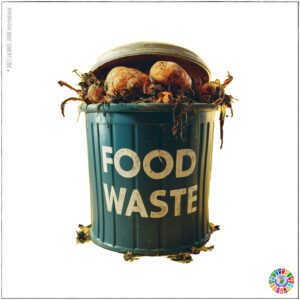The Urgent Need to Combat Food Waste
Food waste is a paradoxical crisis in a world where hunger and food insecurity persist. Each year, approximately one-third of all food produced globally is wasted, amounting to about 1.3 billion tons. This waste has profound environmental, economic, and social consequences. The following essay critically examines the impact of food waste, presents pertinent figures and statistics, and offers examples to underscore the urgent need for a comprehensive food waste awareness campaign.
The Scale of Food Waste
Globally, the scale of food waste is staggering. According to the Food and Agriculture Organization (FAO) of the United Nations, approximately 1.3 billion tons of food are wasted each year. This waste occurs at various stages of the food supply chain, from production and processing to retail and consumption. In developed countries, food waste tends to occur at the consumer level, whereas in developing countries, much of the waste happens during production and post-harvest handling.
In the United States alone, around 40% of food is wasted annually, which equates to about 63 million tons. This waste costs the nation approximately $218 billion each year, reflecting the resources invested in growing, processing, transporting, and disposing of uneaten food. The average American household throws away around $1,600 worth of produce annually, highlighting the economic inefficiency and the need for better management practices.
Environmental Impact
The environmental toll of food waste is severe and multifaceted. Wasted food represents a significant waste of resources, including water, energy, and labor. The FAO estimates that the annual carbon footprint of global food waste is 3.3 billion tons of CO2 equivalent, making it a major contributor to climate change. If food waste were a country, it would be the third-largest emitter of greenhouse gases, after the United States and China.
Water usage is another critical concern. It takes about 1,800 gallons of water to produce a pound of beef and approximately 220 gallons for a loaf of bread. When food is wasted, so is the water used to produce it. This wastage exacerbates water scarcity issues, particularly in regions already struggling with limited water resources.
Moreover, food waste in landfills contributes to methane emissions, a potent greenhouse gas. Organic waste decomposes anaerobically in landfills, releasing methane, which is about 25 times more effective at trapping heat in the atmosphere than CO2 over a 100-year period. This methane emission significantly contributes to global warming and highlights the need for improved waste management and reduction strategies.
Economic Implications
Food waste has substantial economic implications. The financial losses extend beyond the immediate costs of wasted food to include the costs associated with its disposal. Municipalities spend millions of dollars annually on waste management and landfill operations. For instance, the city of New York spends around $100 million each year to transport and dispose of food waste.
At the household level, reducing food waste can lead to significant savings. Families can save money by better planning meals, properly storing food, and creatively using leftovers. Businesses, particularly those in the hospitality and retail sectors, can also benefit economically by implementing strategies to minimize waste, such as donating unsold food and improving inventory management.
Social Consequences
While food waste occurs on a massive scale, food insecurity remains a pressing issue. According to the FAO, nearly 690 million people worldwide are hungry, and millions more are at risk of hunger due to economic downturns, conflicts, and natural disasters. In the United States, about 35 million people, including 10 million children, live in food-insecure households.
Addressing food waste can play a critical role in alleviating hunger. Redirecting just a fraction of wasted food to those in need can make a significant difference. For example, initiatives like Feeding America have been successful in rescuing surplus food from retailers, farmers, and manufacturers and distributing it to food banks and pantries across the country.
Examples and Solutions
Several initiatives and policies have been implemented worldwide to tackle food waste, providing valuable examples of effective strategies:
- France’s Food Waste Law: In 2016, France became the first country to ban supermarkets from throwing away or destroying unsold food. Instead, they are required to donate it to charities and food banks. This law has led to a significant increase in food donations and has raised awareness about the issue among consumers and retailers.
- Denmark’s WeFood: Denmark is home to WeFood, a supermarket that sells surplus and expired food at reduced prices. This initiative not only reduces food waste but also provides affordable food options to consumers, showcasing how creative solutions can address multiple issues simultaneously.
- Ugly Produce Campaigns: Campaigns promoting “ugly” fruits and vegetables, which are often discarded due to cosmetic imperfections, have gained traction. Companies like Imperfect Foods in the United States deliver these products to consumers at a discount, helping to reduce waste and challenge aesthetic standards in the food industry.
- Food Waste Apps: Technology plays a crucial role in combating food waste. Apps like Too Good To Go and Olio connect consumers with surplus food from restaurants, cafes, and households, enabling them to purchase or receive it at a lower cost or for free.
Policy Recommendations
To effectively combat food waste, comprehensive policies and collaborative efforts are essential. Some key policy recommendations include:
- Standardizing Date Labels: Confusion over “sell by,” “use by,” and “best before” dates contribute significantly to food waste. Standardizing date labels can help reduce unnecessary discarding of safe and edible food.
- Encouraging Food Donations: Governments can incentivize food donations by offering tax benefits to businesses that donate surplus food. Additionally, liability protection laws can alleviate concerns about potential legal repercussions.
- Investing in Infrastructure: Improving storage and transportation infrastructure, particularly in developing countries, can significantly reduce post-harvest losses. Investments in refrigeration and better roads can ensure that more food reaches consumers rather than rotting along the supply chain.
- Educational Campaigns: Raising awareness through educational campaigns can empower consumers to make more informed decisions about purchasing, storing, and using food. Schools, community centers, and media can play a pivotal role in disseminating this information.
Conclusion
The issue of food waste is a multifaceted problem with far-reaching consequences. The environmental, economic, and social impacts are profound, highlighting the urgent need for action. By implementing effective policies, supporting innovative solutions, and fostering a culture of awareness and responsibility, we can make significant strides in reducing food waste. This not only conserves valuable resources but also addresses food insecurity, promotes sustainability, and creates a more equitable food system. A concerted effort from governments, businesses, and individuals is essential to turning the tide against food waste and building a more sustainable future.
References:
1. Food and Agriculture Organization of the United Nations (FAO). (2011). “Global Food Losses and Food Waste – Extent, Causes and Prevention.”
2. ReFED. (2016). “A Roadmap to Reduce U.S. Food Waste by 20 Percent.”
3. United Nations Environment Programme (UNEP). (2020). “Food Waste Index Report 2020.”
4. Environmental Protection Agency (EPA). (2017). “Advancing Sustainable Materials Management: 2017 Fact Sheet.”
5. World Wildlife Fund (WWF). (2017). “Fighting Food Waste in America.”
6. Feeding America. (2020). “Hunger and Health: The Impact of Poverty on Food Insecurity.” 7. New York City Department of Sanitation. (2020). “NYC Waste Characterization Study.”




